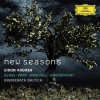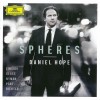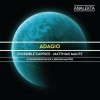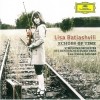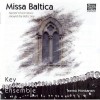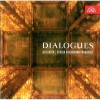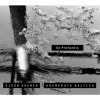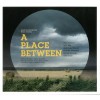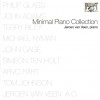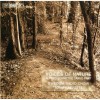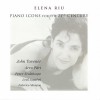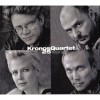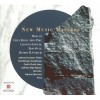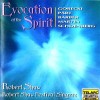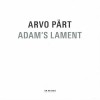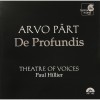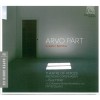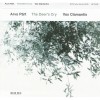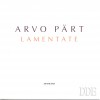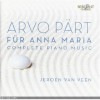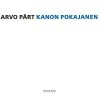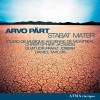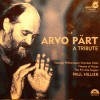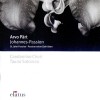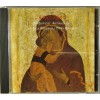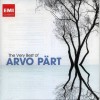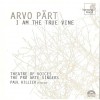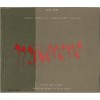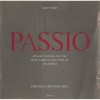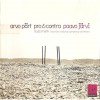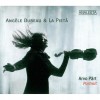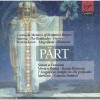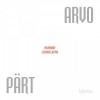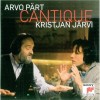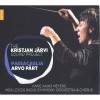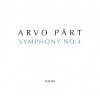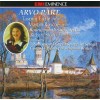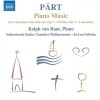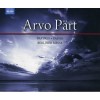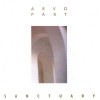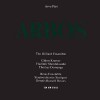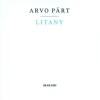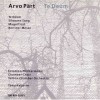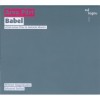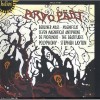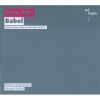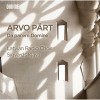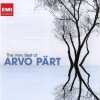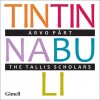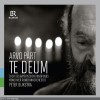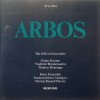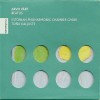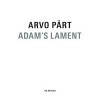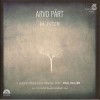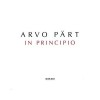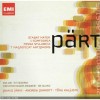Composers
Arvo Pärt (born 11 September 1935; Estonian pronunciation: [ˈɑrvo ˈpært]) is an Estonian classical composer and one of the most prominent living composers of sacred music. Since the late 1970s, Pärt has worked in a minimalist style that employs his self-made compositional technique, tintinnabuli. His music also finds its inspiration and influence from Gregorian chant.
Pärt was born in Paide, Järva County, Estonia. A prolonged struggle with Soviet officials led him to emigrate with his wife and their two sons in 1980. He lived first in Vienna, Austria, where he took Austrian citizenship, and then re-located to Berlin, Germany. He returned to Estonia around the turn of the 21st century and now lives in Tallinn.
Familiar works by Pärt are Cantus In Memoriam Benjamin Britten for string orchestra and bell (1977) and the string quintet "Fratres I" (1977, revised 1983), which he transcribed for string orchestra and percussion, the solo violin "Fratres II" and the cello ensemble "Fratres III" (both 1980).
Pärt is often identified with the school of minimalism and, more specifically, that of mystic minimalism or holy minimalism. He is considered a pioneer of the latter style, along with contemporaries Henryk Górecki and John Tavener. Although his fame initially rested on instrumental works such as Tabula Rasa and Spiegel im Spiegel, his choral works have also come to be widely appreciated.
Pärt's musical education began at age seven. He began attending music school in Rakvere, where his family lived. By the time he reached his early teen years, Pärt was writing his own compositions. While studying composition with Heino Eller at the Tallinn Conservatory in 1957, it was said of him that "he just seemed to shake his sleeves and notes would fall out."
In this period of Estonian history, Pärt was unable to encounter many musical influences from outside the Soviet Union except for a few illegal tapes and scores. Although Estonia had been an independent Baltic state at the time of Pärt's birth, the Soviet Union occupied it in 1940 as a result of the Soviet-Nazi Molotov-Ribbentrop Pact; and the country would then remain under Soviet domination—except for the three-year period of German wartime occupation—for the next 51 years.
Pärt's oeuvre is generally divided into two periods. His early works ranged from rather neo-classical styles influenced by Shostakovich, Prokofiev, and Bartók. He then began to compose using Schoenberg's twelve-tone technique and serialism. This, however, not only earned the ire of the Soviet establishment, but also proved to be a creative dead-end. When early works were banned by Soviet censors, Pärt entered the first of several periods of contemplative silence, during which he studied choral music from the 14th to 16th centuries. In this context, Pärt's biographer, Paul Hillier, observed that "He had reached a position of complete despair in which the composition of music appeared to be the most futile of gestures, and he lacked the musical faith and will-power to write even a single note."
The spirit of early European polyphony informed the composition of Pärt's transitional Third Symphony (1971); and thereafter, he immersed himself in early music, re-investigating the roots of Western music. He studied plainsong, Gregorian chant, and the emergence of polyphony in the European Renaissance.
The music that began to emerge after this period was radically different. This period of new compositions included Fratres, Cantus In Memoriam Benjamin Britten, and Tabula Rasa. Pärt describes the music of this period as tintinnabuli—like the ringing of bells. Spiegel im Spiegel (1978) is a well-known example which has been used in many films. The music is characterised by simple harmonies, often single unadorned notes, or triads, which form the basis of Western harmony. These are reminiscent of ringing bells. Tintinnabuli works are rhythmically simple and do not change tempo. Another characteristic of Pärt's later works is that they are frequently settings for sacred texts, although he mostly chooses Latin or the Church Slavonic language used in Orthodox liturgy instead of his native Estonian language. Large-scale works inspired by religious texts include St. John Passion, Te Deum, and Litany. Choral works from this period include Magnificat and The Beatitudes.
Of his popularity, Steve Reich has written: "Even in Estonia, Arvo was getting the same feeling that we were all getting .... I love his music, and I love the fact that he is such a brave, talented man .... He's completely out of step with the zeitgeist and yet he's enormously popular, which is so inspiring. His music fulfills a deep human need that has nothing to do with fashion." Pärt's music came to public attention in the West, largely thanks to Manfred Eicher who recorded several of Pärt's compositions for ECM Records starting in 1984.
Invited by Walter Fink, he was the 15th composer featured in the annual Komponistenporträt of the Rheingau Musik Festival in 2005 in four concerts. Chamber music included Für Alina for piano, played by himself, Spiegel im Spiegel and Psalom for string quartet. The chamber orchestra of the Bavarian Radio Symphony Orchestra played his Trisagion, Fratres and Cantus along with works of Bach. The Windsbach Boys Choir and soloists Sibylla Rubens, Ingeborg Danz, Markus Schäfer and Klaus Mertens performed Magnificat and Collage über B-A-C-H together with two cantatas of Bach and one of Mendelssohn. The Hilliard Ensemble, organist Christopher Bowers-Broadbent, the Rostocker Motettenchor and the Hilliard instrumental ensemble, conducted by Markus Johannes Langer, performed a program of Pärt's organ music and works for voices (some a cappella), including Pari Intervallo, De profundis and Miserere.
A new composition, Für Lennart, written for the memory of the Estonian President Lennart Meri, was played at his funeral service on 2 April 2006.
In response to the murder of the Russian journalist Anna Politkovskaya in Moscow on 7 October 2006, Pärt declared that all his works performed in 2006–2007 would be in honour of her death:
"Anna Politkovskaya staked her entire talent, energy and—in the end—even her life on saving people who had become victims of the abuses prevailing in Russia."— Arvo Pärt.
Pärt was honoured as the featured composer of the 2008 RTÉ Living Music Festival[8] in Dublin, Ireland. He was also commissioned by Louth Contemporary Music Society to compose a new choral work based on St. Patricks Breastplate, which premiered in 2008 in Louth, Ireland. The new work is called The Deers Cry. This is the composer's first Irish commission, having its debut in Drogheda and Dundalk in February 2008.
His recent (2008) Symphony No. 4 is named “Los Angeles” and was dedicated to Mikhail Khodorkovsky. It is Pärt's first symphony written in over 37 years, since 1971's Symphony No. 3. It premiered in Los Angeles, California, at the Walt Disney Concert Hall on 10 January 2009, and has been nominated for a GRAMMY for Best Classical Contemporary Composition.
Recently Added
Biography
Arvo Pärt (born 11 September 1935; Estonian pronunciation: [ˈɑrvo ˈpært]) is an Estonian classical composer and one of the most prominent living composers of sacred music. Since the late 1970s, Pärt has worked in a minimalist style that employs his self-made compositional technique, tintinnabuli. His music also finds its inspiration and influence from Gregorian chant.
Pärt was born in Paide, Järva County, Estonia. A prolonged struggle with Soviet officials led him to emigrate with his wife and their two sons in 1980. He lived first in Vienna, Austria, where he took Austrian citizenship, and then re-located to Berlin, Germany. He returned to Estonia around the turn of the 21st century and now lives in Tallinn.
Familiar works by Pärt are Cantus In Memoriam Benjamin Britten for string orchestra and bell (1977) and the string quintet "Fratres I" (1977, revised 1983), which he transcribed for string orchestra and percussion, the solo violin "Fratres II" and the cello ensemble "Fratres III" (both 1980).
Pärt is often identified with the school of minimalism and, more specifically, that of mystic minimalism or holy minimalism. He is considered a pioneer of the latter style, along with contemporaries Henryk Górecki and John Tavener. Although his fame initially rested on instrumental works such as Tabula Rasa and Spiegel im Spiegel, his choral works have also come to be widely appreciated.
Pärt's musical education began at age seven. He began attending music school in Rakvere, where his family lived. By the time he reached his early teen years, Pärt was writing his own compositions. While studying composition with Heino Eller at the Tallinn Conservatory in 1957, it was said of him that "he just seemed to shake his sleeves and notes would fall out."
In this period of Estonian history, Pärt was unable to encounter many musical influences from outside the Soviet Union except for a few illegal tapes and scores. Although Estonia had been an independent Baltic state at the time of Pärt's birth, the Soviet Union occupied it in 1940 as a result of the Soviet-Nazi Molotov-Ribbentrop Pact; and the country would then remain under Soviet domination—except for the three-year period of German wartime occupation—for the next 51 years.
Pärt's oeuvre is generally divided into two periods. His early works ranged from rather neo-classical styles influenced by Shostakovich, Prokofiev, and Bartók. He then began to compose using Schoenberg's twelve-tone technique and serialism. This, however, not only earned the ire of the Soviet establishment, but also proved to be a creative dead-end. When early works were banned by Soviet censors, Pärt entered the first of several periods of contemplative silence, during which he studied choral music from the 14th to 16th centuries. In this context, Pärt's biographer, Paul Hillier, observed that "He had reached a position of complete despair in which the composition of music appeared to be the most futile of gestures, and he lacked the musical faith and will-power to write even a single note."
The spirit of early European polyphony informed the composition of Pärt's transitional Third Symphony (1971); and thereafter, he immersed himself in early music, re-investigating the roots of Western music. He studied plainsong, Gregorian chant, and the emergence of polyphony in the European Renaissance.
The music that began to emerge after this period was radically different. This period of new compositions included Fratres, Cantus In Memoriam Benjamin Britten, and Tabula Rasa. Pärt describes the music of this period as tintinnabuli—like the ringing of bells. Spiegel im Spiegel (1978) is a well-known example which has been used in many films. The music is characterised by simple harmonies, often single unadorned notes, or triads, which form the basis of Western harmony. These are reminiscent of ringing bells. Tintinnabuli works are rhythmically simple and do not change tempo. Another characteristic of Pärt's later works is that they are frequently settings for sacred texts, although he mostly chooses Latin or the Church Slavonic language used in Orthodox liturgy instead of his native Estonian language. Large-scale works inspired by religious texts include St. John Passion, Te Deum, and Litany. Choral works from this period include Magnificat and The Beatitudes.
Of his popularity, Steve Reich has written: "Even in Estonia, Arvo was getting the same feeling that we were all getting .... I love his music, and I love the fact that he is such a brave, talented man .... He's completely out of step with the zeitgeist and yet he's enormously popular, which is so inspiring. His music fulfills a deep human need that has nothing to do with fashion." Pärt's music came to public attention in the West, largely thanks to Manfred Eicher who recorded several of Pärt's compositions for ECM Records starting in 1984.
Invited by Walter Fink, he was the 15th composer featured in the annual Komponistenporträt of the Rheingau Musik Festival in 2005 in four concerts. Chamber music included Für Alina for piano, played by himself, Spiegel im Spiegel and Psalom for string quartet. The chamber orchestra of the Bavarian Radio Symphony Orchestra played his Trisagion, Fratres and Cantus along with works of Bach. The Windsbach Boys Choir and soloists Sibylla Rubens, Ingeborg Danz, Markus Schäfer and Klaus Mertens performed Magnificat and Collage über B-A-C-H together with two cantatas of Bach and one of Mendelssohn. The Hilliard Ensemble, organist Christopher Bowers-Broadbent, the Rostocker Motettenchor and the Hilliard instrumental ensemble, conducted by Markus Johannes Langer, performed a program of Pärt's organ music and works for voices (some a cappella), including Pari Intervallo, De profundis and Miserere.
A new composition, Für Lennart, written for the memory of the Estonian President Lennart Meri, was played at his funeral service on 2 April 2006.
In response to the murder of the Russian journalist Anna Politkovskaya in Moscow on 7 October 2006, Pärt declared that all his works performed in 2006–2007 would be in honour of her death:
"Anna Politkovskaya staked her entire talent, energy and—in the end—even her life on saving people who had become victims of the abuses prevailing in Russia."— Arvo Pärt.
Pärt was honoured as the featured composer of the 2008 RTÉ Living Music Festival[8] in Dublin, Ireland. He was also commissioned by Louth Contemporary Music Society to compose a new choral work based on St. Patricks Breastplate, which premiered in 2008 in Louth, Ireland. The new work is called The Deers Cry. This is the composer's first Irish commission, having its debut in Drogheda and Dundalk in February 2008.
His recent (2008) Symphony No. 4 is named “Los Angeles” and was dedicated to Mikhail Khodorkovsky. It is Pärt's first symphony written in over 37 years, since 1971's Symphony No. 3. It premiered in Los Angeles, California, at the Walt Disney Concert Hall on 10 January 2009, and has been nominated for a GRAMMY for Best Classical Contemporary Composition.
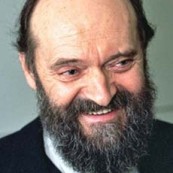

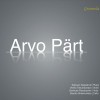
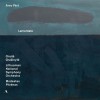
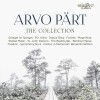
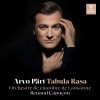
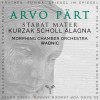
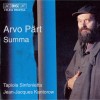
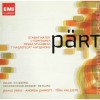
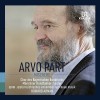
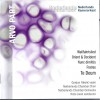
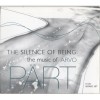



![Great European Organs. 40-John Scott [St Giles' Cathedral Edinburgh]](http://static.classicalm.com/repository/collection-cover/small/919-img1341827119687358.jpg)
